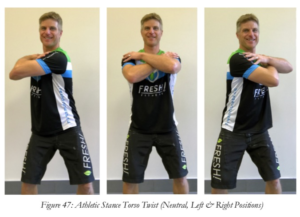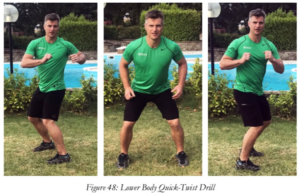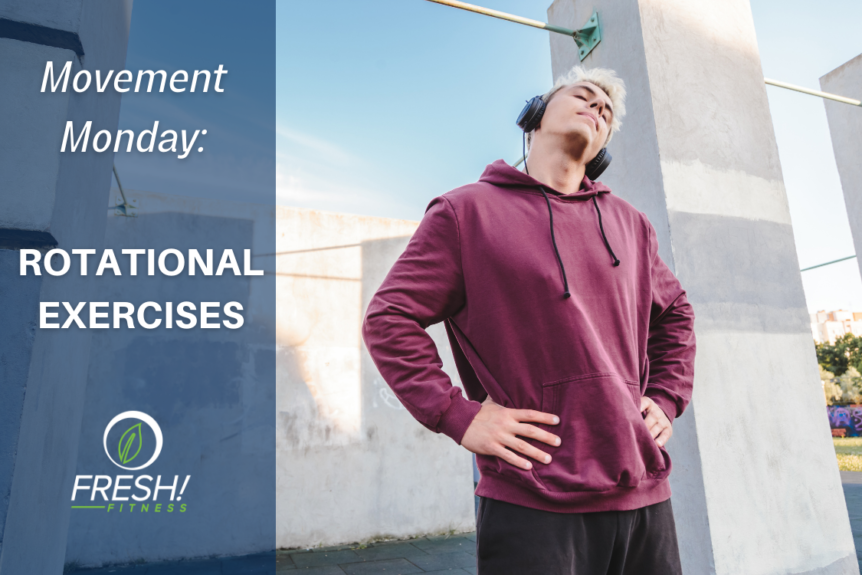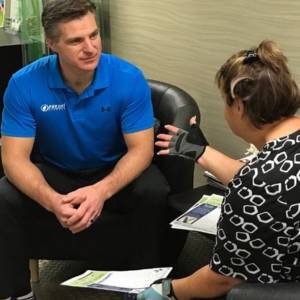Music has been called the soundtrack of our life. Way back in 1963, The Beatles taught us to “Twist and Shout”, and Kylie Minogue made “Spinning Around” popular at the turn of the new millennium. Since I’m a huge fan of music from most genres, I thought it was a perfect segue to today’s topic the rotational exercises, and another passion of mine – movement.
Despite almost 40 years between the songs, what these artists got right is the importance of rotation in fitness and life. Ok. Yes, the intro was a bit cheesy, but it got your attention!
In our Movement Foundations Course, you will learn how to perform foundational movements correctly to maximize the benefits of your workouts and daily activities.
Our body is uniquely set up to perform rotation. It’s one of the most common movements in sport and recreation, yet it’s almost never trained in traditional workouts.
To highlight the importance of this foundational movement pattern, here is an excerpt from the Movement Pillar of my book:
Any activity that involves a ball, racquet, implement, or contact is almost completely based on rotational power. Yet this is neglected by most people (and many training professionals).
Rotation and anti-rotation (the ability to withstand rotational forces) are key components of almost every other movement pattern, particularly the gait, push, pull, and lunge patterns.
As babies, the rotation starts with our initial attempts to roll over. Our head turns, our shoulders and torso follow (perhaps we even reach for the object we want), and finally, our hips and legs follow through to finish the roll.
Effective rotation involves control and coordination of most major joints in the body, particularly the spine, shoulders, hips, muscles related to these areas, and important fascial lines throughout the body. Don’t worry, there won’t be a test on this, but it’s important to understand how your body developed, and how it functions at the basic level.
Rotation is part of every step we take, as well as with activities that involve striking a ball or opponent. This includes all major sports and martial arts. Anti-rotational forces are present every time we push or pull with one arm or one leg or must overcome some type of external force. This is what happens when you push or pull open a door, someone bumps against you, or you need to pick up something with one arm (like a suitcase).
Despite the common presence of rotation in daily life, people trying to “stay fit,” have created a serious problem that needs to be addressed. Almost all popular gym exercises and training styles seriously neglect rotational exercises.
Picture this all too common scenario:
“Bob” and “Jane” like to be active, but they’ve been working a lot lately and neglecting their health. They’ve both put on a few extra pounds, and decided that they need to get back into shape. They head to the gym and start doing some weights and cardio. This includes the machine circuit (leg press, seated chest press, seated row, bicep curls, tricep press, leg curls, crunches, seated shoulder press) with step and bike intervals between exercises. Once a week they take a spin class, and another day, each week, they go for a jog.
After a month or two, they are feeling more fit, and they’ve lost a few pounds. The weather is getting nicer, and they decide they want to get back into golf and tennis. So, they decide to do a day of golf on the weekend and play tennis on the other day.
Now, most people (including a fair number of trainers) would look at this training program and think it was appropriate. Jane and Bob are active, exercising most days of the week, and excited about taking on new activities.

On the surface, this is good. But, when we look deeper, we realize that without some important changes, Jane and Bob will be headed straight to their local physiotherapist.
The exercises and activities they had been doing prior to tennis and golf were “linear”. Those exercises did not involve any significant rotation. They were also strength or endurance based. However, when we look at the demands of both tennis and golf, it paints a different picture of what is needed to succeed. Both tennis and golf are “high-speed rotational power” sports. They involve a lot of rotation, done quickly, and through wide ranges of motion.
This means that Jane and Bob have not properly prepared their body for the demands of the new activities, and are putting themselves at high risk of injury.
This risk is even exaggerated because they both “feel” fit, and are confident in their abilities. Simply adding some rotational exercises, and gradually increasing the range and speed of these motions would greatly decrease this injury risk, as well as improve their performance.
I’ve included this scenario because it’s so common these days.
People who believe they are fit and exercise regularly, are not properly preparing their body for the demands that life dictates, or for the activities that they are performing.
This can even be said of many “uber-fit” CrossFitters, though they would argue the point vehemently. It’s rare to see a rotational pattern in a traditional CrossFit workout, and they typically don’t include as many single-arm, single-leg, or cross-body motions as I feel is warranted. Yet, according to the CrossFit manifesto, these “athletes” believe they are training for every conceivable scenario in life.
When practicing rotational exercises, it’s important to start with proper posture. With your spine in ideal position, you are optimally set up for successful rotation. When slouched, or over extended, the vertebrae (and facet joints) are poorly aligned and can cause issues such as excess wear and tear on the joints, or pinched nerves.
The first step is to determine your true spinal range of motion and to practice properly activating the right muscles throughout the motion.
Here are a couple of simple exercises to practice rotation. Start slow, gain competency first, and then gradually begin to increase the speed and range of motion (ROM).
Athletic Stance Torso Twist
Stand in a tall, athletic stance. Think of it as a mini squat. Your knees should be slightly bent, hips back, and good posture with your upper body slightly hinged forward at the hip. Cross your arms over your chest with your hands on opposite shoulders, or clasp them straight out in front of your chest (as shown in image).
From here, slowly turn your upper body as far as possible to the left, while keeping your hips stable (facing forward), and maintaining correct posture (still neutral, but just rotated). Take notice of how many degrees you turned, and how it felt.
-
Which muscles were working?
-
Was there any tightness, restriction, or pain? If so, where?
-
Did you have any movement in your hips, knees, or feet?
-
Were you able to maintain posture throughout the rotation?

Turn to the right. Make the same observations. Were you able to rotate further on one side? Was one side easier or more coordinated? This exercise is a simple baseline to get the correct muscles firing, at the correct angles, and to practice smooth, controlled rotation. Once you’ve mastered this motion, extend your arms in front of you, and use some light resistance with a cable or tubing band.
Lower Body Quick Twist
This is a progression from the first exercise because agility and quickness are involved. Much rotation in life happens at high speeds and loads. This exercise allows you to slowly begin progressing the challenge and making the necessary technical adjustments under safe conditions. It also teaches you to stabilize the torso while rotating the lower body. Anyone who snowboards, skis, or plays an agility-based sport such as soccer, hockey, basketball, or football will benefit from improving this skill.
In the same starting position as the previous exercise, turn your upper body as far to the left as possible. Keep your chest and upper body stable in that position. Notice the position and orientation of your feet. They should be about shoulder-width apart and pointed forward in the direction of your hips.
Hop slightly in a vertical direction. While in the air, quickly rotate the hips and feet 180 degrees, while keeping the upper body in the same direction. Land balanced, in control, and ready to reverse the motion with the lower body.
To wrap your head around this motion, imagine that someone is holding your shoulders. You can’t rotate them, but you can still rotate everything below that, particularly your spine and the direction your pelvis faces. Note that this exercise does not involve the femur (thigh bone) rotating in the hip socket. It’s completely about spinal rotation and core activation.
Hop back and forth, changing the direction of your hips by 180 degrees each time. Your feet should land in the same spot, but just facing the opposite direction. Start slow, gain control, competency, and ROM. Once this has been accomplished, work on increasing the speed and responsiveness of the motion. You can even count the number of correct rotations you do in 10 seconds.

Hopefully, this helps you refresh your fitness program by adding some rotational exercises to the mix.
If you would benefit from some expert guidance in doing this, just book your FREE Coaching Success Session with FRESH! team.
Make sure to follow us on Facebook, Instagram, and YouTube, for more health and fitness tips.




